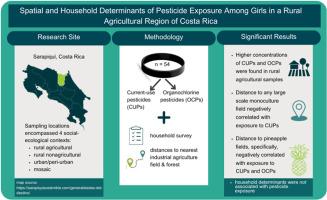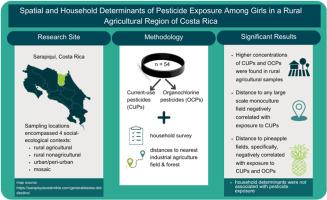哥斯达黎加农村女孩农药暴露的决定因素:一项硅胶腕带研究
IF 7.3
2区 环境科学与生态学
Q1 ENVIRONMENTAL SCIENCES
引用次数: 0
摘要
儿童时期接触农药会扰乱内分泌和代谢功能,增加患慢性病的风险。因此,了解青年农药接触的决定因素是很重要的,特别是在农村农业地区,由于在附近的田地中施用农药,个人更有可能接触农药。在这里,我们提出了新的数据,从第一次调查使用硅胶腕带测量个人被动化学暴露在哥斯达黎加。我们评估了社会生态背景(SECs)的贡献:在哥斯达黎加农村农业区的女孩样本中,农村农业、农村非农业、城市/城市周边和马赛克)、家庭因素(家庭成员的组成、职业和收入)、个人农药暴露认知、距离农田(普通、菠萝和香蕉)和森林对当前使用农药(CUPs)和遗留有机氯农药(ocp)暴露的距离。佩戴腕带的平均时间为4.5天,使用液相/气相色谱和质谱(LC/MS/MS)分析农药水平。与来自城市/城郊和农村非农业地区的参与者相比,农村农业参与者的农药浓度较高,暴露程度的差异与靠近大规模单一栽培,特别是菠萝种植园有关。通过提供儿童和青少年个人农药暴露的第一份文件Sarapiquí,我们表明农药暴露不依赖于家庭因素,而是与密集的菠萝农业有关。这表明施用于菠萝田的农药并不包含在种植园内。本文章由计算机程序翻译,如有差异,请以英文原文为准。


Determinants of pesticide exposure among girls in rural Costa Rica: A silicone wristband study
Pesticide exposure during childhood can disrupt endocrine and metabolic functions, increasing the risk of chronic diseases. Thus, it is important to understand the determinants of pesticide exposure among youth, especially in rural agricultural areas where individuals are more likely to be exposed due to the application of pesticides in nearby fields. Here we present novel data from the first investigation to use silicone wristbands to measure individual passive chemical exposure in Costa Rica. We evaluated the contributions of social-ecological context (SECs: rural agricultural, rural nonagricultural, urban/peri-urban, and mosaic), household factors (composition, occupation of household members, and income), perceptions of personal pesticide exposure, and distance to agricultural fields (general, pineapple, and banana) and forest to exposure to current-use pesticides (CUPs) and legacy organochlorine pesticides (OCPs) among a sample of girls from a rural agricultural region of Costa Rica. Wristbands were worn for an average of 4.5 days, and pesticide levels were analyzed using liquid/gas chromatography and mass spectrometry (LC/MS/MS). Higher pesticide concentrations were found in rural agricultural participants compared to those from urban/peri-urban and rural nonagricultural areas, with variation in exposure linked to proximity to large-scale monoculture and, particularly, pineapple plantations. By providing the first documentation of personal pesticide exposure among children and adolescents from Sarapiquí, we show that exposure to pesticides is not dependent on household factors but is connected to proximity to intensive pineapple agriculture. This suggests that pesticides applied to pineapple fields are not contained within the plantations.
求助全文
通过发布文献求助,成功后即可免费获取论文全文。
去求助
来源期刊

Environmental Pollution
环境科学-环境科学
CiteScore
16.00
自引率
6.70%
发文量
2082
审稿时长
2.9 months
期刊介绍:
Environmental Pollution is an international peer-reviewed journal that publishes high-quality research papers and review articles covering all aspects of environmental pollution and its impacts on ecosystems and human health.
Subject areas include, but are not limited to:
• Sources and occurrences of pollutants that are clearly defined and measured in environmental compartments, food and food-related items, and human bodies;
• Interlinks between contaminant exposure and biological, ecological, and human health effects, including those of climate change;
• Contaminants of emerging concerns (including but not limited to antibiotic resistant microorganisms or genes, microplastics/nanoplastics, electronic wastes, light, and noise) and/or their biological, ecological, or human health effects;
• Laboratory and field studies on the remediation/mitigation of environmental pollution via new techniques and with clear links to biological, ecological, or human health effects;
• Modeling of pollution processes, patterns, or trends that is of clear environmental and/or human health interest;
• New techniques that measure and examine environmental occurrences, transport, behavior, and effects of pollutants within the environment or the laboratory, provided that they can be clearly used to address problems within regional or global environmental compartments.
 求助内容:
求助内容: 应助结果提醒方式:
应助结果提醒方式:


